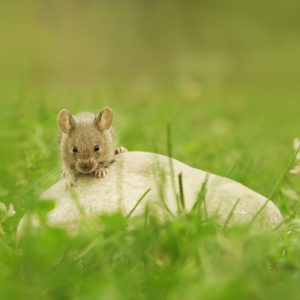Vole Winter Damage to Lawns and Trees
By Chris Williams on January 9, 2012.
Q. Last winter we had something damaging our lawn. In the spring, there were winding tunnels all through the grass. Do you think the tunnels were from moles? We’ve never seen any actual moles.
A. Not moles, but probably meadow voles. Moles tunnel underground while meadow voles tunnel on the surface. Voles are sometimes incorrectly called meadow mice or field mice. They are rodents, but not mice. A vole is slightly larger than a house mouse, with a short tail, short ears, small eyes, and a stockier body.
Voles are vegetarians and are notorious for clipping off seedlings, gnawing the roots off of plants, and uprooting plants from the garden. They will feed on grasses and the roots of perennial plants under winter snow cover. Unlike many other animals, voles do not hibernate in the winter. In fact, they are very active and snow doesn’t deter them. They move along in their tunnel system underneath the protective snow cover and continue to feed on whatever they can find.
We assume that voles are the most damaging during the growing season when we can see where they have chewed and uprooted plants. But actually, most of the serious damage that voles do is from late fall to early spring when most of us aren’t paying any attention to what’s going on in our yards. Unfortunately, most homeowners don’t discover winter vole damage until spring when it’s too late for preventive measures.
 When the snow has melted, you may see small surface tunnels (1 to 2 inches wide) winding through your lawn with burrow openings. You may see piles of dead grass or small depressions filled with grass. The lawn damage is unsightly, but rarely permanent. You can repair much of the damage by simply raking to remove dead grass. Even grass that has been eaten to the ground should resprout and recover.
When the snow has melted, you may see small surface tunnels (1 to 2 inches wide) winding through your lawn with burrow openings. You may see piles of dead grass or small depressions filled with grass. The lawn damage is unsightly, but rarely permanent. You can repair much of the damage by simply raking to remove dead grass. Even grass that has been eaten to the ground should resprout and recover.
More serious is the gnawing damage that voles can do to trees and shrubs during winter. Because green vegetation is scarce, voles turn to feeding on woody plants during winter. From their tunnels under the snow, they can gnaw on the bark of trees and shrubs up as high as the top of the snow cover. You may see irregular tooth marks (about 1/16 inch wide and 3/8 inch long) at various angles on trunks. Small trees can be girdled and killed.
Even if you don’t have much snow during the winter, voles can cause the same kind of damage under heavy leaf cover as well. Rake leaves off of lawns and flower beds to keep voles from tunneling underneath and chewing off the crowns and roots of perennial plants.
To discourage voles and prevent winter damage, keep mowing your lawn until freezing weather sets in but don’t mow the grass shorter than two inches or it might suffer from winter injury. Remove excess thatch and keep mulch on beds no more than two inches deep to discourage vole tunneling. Remove materials that provide cover for voles like weeds, wild grasses, or litter. Unfortunately, plastic weed barriers on beds encourage voles. If you get heavy snow, clear the snow around trees to remove the voles’ cover. To keep voles from girdling trees, you can protect the trunk with a wire mesh cylinder buried 3 to 6 inches below the soil and extending up to 18 inches above the surface. You can also split PVC pipe with a saw and place a collar around young trees.
Meadow vole populations fluctuate and peak every 2 to 5 years. Don’t assume that if you had no vole problems last winter, that this winter will be the same. Also, the heavier the snow cover, the heavier the resulting vole damage. If you have a large vole population going into the winter, you might want to have a pest control company trap or bait them before the snows come. Call Colonial Pest for help. Remember the voles will remain active and you may not be able to see that activity under snow.